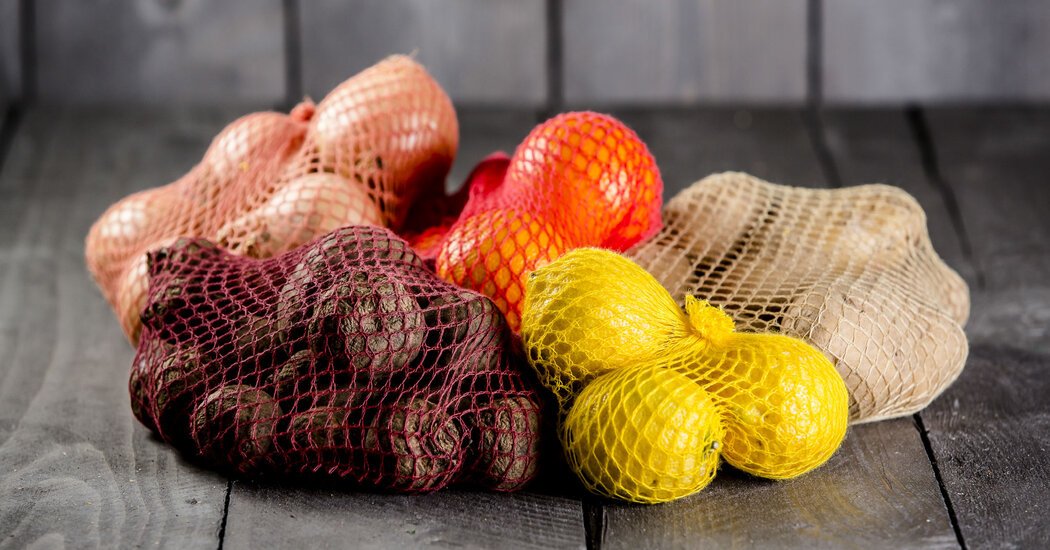If it looks as if plastic surrounds almost each cucumber, apple and pepper within the produce aisle, it does.
What started with cellophane in the 1930s picked up pace with the rise of plastic clamshells within the Nineteen Eighties and bagged salads within the Nineties. On-line grocery procuring turbocharged it.
However now the race is on for what individuals who develop and promote vegatables and fruits are calling a moon shot: breaking plastic’s stranglehold on produce.
In a March survey amongst produce professionals on LinkedIn, the shift to biodegradable materials was voted the top trend. “It’s large,” stated Soren Bjorn, chief government officer of Driscoll’s, the world’s largest grower of berries, which has switched to paper containers in lots of European markets.
Spain has a plastic tax. France has severely limited plastic-wrapped produce and the European Union is about so as to add its own restrictions. Canada is attempting to hammer out a plan that might get rid of plastic packaging of produce by 95 % by 2028. In the USA, 11 states have already restricted plastic packaging. As a part of a sweeping anti-waste plan, the Biden administration is asking for brand new methods to package deal meals that makes use of climate-friendly, antimicrobial materials designed to cut back reliance on plastic.
So we agree that eliminating plastic is the reply?
Lowering using plastic is an apparent option to push again in opposition to a altering local weather. Plastic is created from fossil fuels, the largest contributor to greenhouse gases. It chokes the oceans and seeps into the meals chain. Estimates vary, however about 40 % of plastic waste comes from packaging.
But plastic has to this point been the best device to battle one other environmental menace: meals waste.
Wirecutter shares ideas for holding your produce recent for weeks.
Promoting produce is like holding a melting ice dice and asking how a lot somebody can pay for it. Time is of the essence, and plastic works effectively to gradual the decay of greens and fruit. Meaning much less produce is tossed into the rubbish, the place it creates virtually 60 percent of landfill methane emissions, based on a 2023 report by the Environmental Safety Company.
A Swiss study in 2021 confirmed that every rotting cucumber thrown away has the equal environmental impression of 93 plastic cucumber wrappers.
Meals is the most common material in landfills. The common American household of 4 spends $1,500 every year on meals that finally ends up uneaten. Of that, vegatables and fruits make up almost half of all family meals waste, in accordance to research from Michigan State College. And it’s not simply the wasted meals that provides to local weather change. The farming and transportation wasted to provide meals that’s discarded impacts the local weather, too.
Stopping meals waste and lowering using plastic aren’t mutually unique objectives. Each are excessive on the agenda of the Biden administration, which in December issued a draft of a nationwide technique to halve the nation’s meals loss by 2030.
Are Individuals on board?
Customers increasingly report that utilizing much less plastic and packaging issues to them, however their procuring habits inform a special story. American buyers purchased $4.3 billion price of bagged salad final yr, based on the Worldwide Contemporary Produce Affiliation. Advertising and marketing experiments and independent research each present that worth, high quality and comfort drive meals selections greater than environmental issues.
Grocers are having to make powerful choices, too. Consumers have complained about having to purchase produce that has already been packed in plastic and priced. Not promoting by weight is less complicated for the shop, whose staff don’t must weigh every merchandise. But it surely usually forces buyers to purchase greater than they want.
Battle strains appear to be drawn between the never-plastic crowd and buyers preferring the benefit of recent salad greens delivered to their door.
“The packaging dialog is being held hostage by one aspect or the opposite,” stated Max Teplitski, chief science officer of the Worldwide Contemporary Produce Affiliation. He leads the Alliance for Sustainable Packaging for Foods, a group of trade commerce teams that fashioned in January.
The group’s precedence is to guarantee that any adjustments in packaging will hold meals secure and protect its high quality.
What options to plastic are coming?
Listed below are a number of new ideas headed to the produce aisle:
Baggage from bushes. An Austrian firm is using beechwood trees to make biodegradable cellulose internet baggage to carry produce. Different firms supply comparable netting that decomposes inside a number of weeks.
Movie from peels. Orange peels, shrimp shells and different natural waste are being changed into movie that can be utilized like cellophane, or made into baggage. An edible coating created from plant-based fatty acids is sprayed on cucumbers, avocados and different produce offered at many main grocery shops. They work in a approach much like the wax coating generally used on citrus and apples.
Clamshells from cardboard. Plastic clamshells are a $9.1 billion business in the USA, and the variety of growers who use them is huge. Changing them shall be an unlimited problem, notably for extra fragile vegatables and fruits. Plenty of designers are attempting. Driscoll’s has been working to develop paper containers to be used in the USA and Canada. Within the meantime, the corporate is utilizing more recycled plastic in its clamshells in the USA.
Ice that looks like gelatin. Luxin Wang and different scientists on the College of California, Davis, have invented reusable jelly ice. It’s lighter than ice and doesn’t soften. It may get rid of the necessity for plastic ice packs, which may’t be recycled. After a few dozen makes use of, the jelly ice might be tossed right into a backyard or the rubbish, the place it dissolves.
Bins with ambiance. Broccoli is normally shipped in wax-coated packing containers full of ice. The soggy cartons can’t be recycled. Iceless broccoli shipping containers use a mixture of gases that assist protect the vegetable as an alternative of chilling it with ice, which is heavy to ship and might transmit pathogens when it melts. Different sustainable, lighter delivery cartons are being designed to remove ethylene, a plant hormone that encourages ripening.
Containers from crops. Rice-paddy straw left over after harvests, grasses, sugar cane stalks and even meals waste are all being changed into trays and packing containers which might be both biodegradable or might be composted.
Drawback solved, proper?
Hardly. Even when each grower and grocer began utilizing packaging that could possibly be recycled or composted, America’s infrastructure for turning it into one thing in addition to trash is spotty at finest. Less than 10 percent of all plastic is recycled, a determine that’s even decrease for produce packaging, stated Eva Almenar, a professor at Michigan State College’s School of Packaging. Solely a small fraction of packaging labeled compostable stays out of the landfill.
Simply 3 percent of wasted meals lands at industrial composting facilities. A number of states have no commercial operations that may compost meals waste.
“We don’t have proper the know-how, and we don’t have the gathering methods,” Dr. Almenar stated.
Even when the infrastructure have been in place, individuals’s habits aren’t. “Customers haven’t any clue about what means inexperienced, compostable or recyclable,” she stated.
Virtually, nobody has but devised an reasonably priced plastic different that may be recycled or composted and in addition retains vegatables and fruits secure and recent. Plastic permits packers to modify the mix of gases inside a package deal in a approach that extends the shelf life and the standard of recent produce.
“The pushback you might be getting is that when you get rid of plastic and go to fiber, it depletes the shelf life actually quick,” stated Scott Crawford, vice chairman of merchandising for Baldor Specialty Meals and a veteran of each Entire Meals Market and Contemporary Direct. “The query is which aspect of the balloon are you attempting to squeeze?”
The perfect answer, he stated, could be to return to the times earlier than plastic, when grocers stacked their produce by hand and nobody demanded that seasonal fruit like blueberries be obtainable year-round.
“I don’t assume we’re going to stay to see that,” he stated.
Comply with New York Times Cooking on Instagram, Facebook, YouTube, TikTok and Pinterest. Get common updates from New York Instances Cooking, with recipe options, cooking ideas and procuring recommendation.




